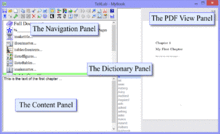TexLab
 | |
 | |
| Original author(s) | Sergio Ledesma |
|---|---|
| Developer(s) | Sergio Ledesma |
| Stable release |
1.2
|
| Development status | In progress |
| Written in | C++ |
| Operating system | Windows |
| Platform | Win32 |
| Available in | English |
| Type | Freeware |
| Website | TexLab website |
TexLab is a free TeX editor designed for Microsoft Windows. It was created using Wintempla.[1] Wintempla is a set of C++ classes to wrap the Windows API's. TexLab is multi-thread program that uses MiKTeX to typeset documents by calling: LaTeX,[2] XeTeX[3] or pdfTeX.[4] MiKTeX is the version of LaTeX for Microsoft Windows; it consists of a set of tools to process text.[5] Christian Schenk is the creator of MiKTeX, he studied Computer Science at TU Berlin. When Christian owned his first PC, he began working on a fun project; this project eventually became MiKTeX.
As LaTeX output is a DVI file, TexLab may require Dvips and DviPdfm to produce PDF documents. This format was designed by David R. Fuchs and was implemented by Donald E. Knuth. This format is used to store documents in a file (similar to DOCX or PDF). To open a DVI file and visualize the document, you can use: YAP,[6] XDVI,[7] WINDVI,[8] etc.
Document Organization
A LaTeX file is a text file with special control sequences to create documents. These control sequences begin with a backslash and they are used to declared environments. LaTeX is mainly used to create scientific documents in many fields such as: mathematics, physics, computer science, optics, etc. The main text file may require a set of external files such as images, class files, etc. In order to keep the files organized, TexLab requires a project file and a project folder. The project folder holds all the required files to create the document, while the project file (a .tax file) stores settings and information to create the document. TexLab does not operate using a .tex file, instead the document is divided in small components. Each component represents a LaTeX environment[9] and can be individually edited and managed.
GUI Organization
TexLab GUI has four panels. The navigation panel is used to add and remove LaTeX environments. The content panel is used to edit the selected environment in the navigation panel. The PDF View panel presents a preview of the document; this view is updated as the user edits the content of the document. The PDF View internally calls the poppler library in order to manipulate PDF documents. The dictionary view displays spelling suggestions. In version 1.2, TexLab provides spelling in: English, Spanish and German.
Templates
There are two types of templates: documents templates and equation templates. Document templates are used to start a new document with some pre-defined structure. After the document has been created, it is possible to modify its structure so that the document meets a specific format. In version 1.2, TexLab provides templates for: articles, Elsevier articles, books, letters, presentations, proceedings, thesis, and simple documents. Equation templates are used to insert an equation in any type of document.
Tools
As LaTeX documents require EPS images, TexLab provides a set of tools to manipulate images and PDF documents. These tools are based on the poppler library and Sam2p.[10] Poppler is a fork of xpdf which was written by Derek Noonburg; Albert Astals Cid is the current maintainer of Poppler. Sam2p is a command line utility written in ANSI C++ that converts some image formats into Adobe PostScript or PDF files and several other formats
Bibliography
There are two environments to manage a bibliography in LaTeX: \bibliography and \thebibliography.[11] A bibliography file is a database file with the extension .bib that can be used to stored bibliography items. The main advantage of using a bibliography file is that it is possible to make a reference from a document to any item in the database. TexLab provides a bibliography database editor to add, remove or edit items in the database.
File extensions
- .tex
- TeX or LaTeX file (an ASCII, UTF-8 or UNICODE text file)
- .bib
- A bibliography file
- .tax
- A TexLab file
See also
References
- ↑ Wintempla. Microsoft Visual Studio Gallery. Retrieved October 19, 2016.
- ↑ LaTeX. Retrieved October 23, 2016.
- ↑ XeTeX. Retrieved October 23, 2016.
- ↑ PdfTeX. Retrieved October 23, 2016.
- ↑ MiKTeX. Retrieved October 23, 2016.
- ↑ Yap. Retrieved October 23, 2016.
- ↑ xdvi. Retrieved October 23, 2016.
- ↑ WinDvi. Retrieved October 23, 2016.
- ↑ LaTeX Environments. Retrieved October 23, 2016.
- ↑ sam2p. Retrieved October 23, 2016.
- ↑ LaTeX Bilbiography. Retrieved October 23, 2016.